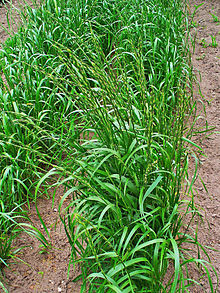Lolium temulentum: Difference between revisions
m Bot: Migrating 19 interwiki links, now provided by Wikidata on d:q162088 (Report Errors) |
No edit summary |
||
| Line 2: | Line 2: | ||
{{taxobox |
{{taxobox |
||
|name = ''Lolium temulentum'' |
|name = ''Lolium temulentum'' |
||
|image = Illustration Lolium temulentum0.jpg |
|||
|regnum = [[Plantae]] |
|regnum = [[Plantae]] |
||
|unranked_divisio = [[Angiosperms]] |
|unranked_divisio = [[Angiosperms]] |
||
Revision as of 09:33, 27 February 2013
| Lolium temulentum | |
|---|---|
| Scientific classification | |
| Kingdom: | |
| (unranked): | |
| (unranked): | |
| (unranked): | |
| Order: | |
| Family: | |
| Genus: | |
| Species: | L. temulentum
|
| Binomial name | |
| Lolium temulentum | |
Lolium temulentum, typically known as darnel, poison darnel or cockle, is an annual plant that forms part of the Poaceae family and part of the Lolium genus. The plant stem can grow up to one meter tall, with inflorescence in the ears and purple grain. It has a global distribution.
Growth

Darnel usually grows in the same production zones as wheat and is considered a weed. The similarity between these two plants is so great that in some regions, darnel is referred to as "false wheat".[1] It bears a close resemblance to wheat until the ear appears. The spikes of L. temulentum are more slender than those of wheat. The spikelets are oriented edgeways to the rachis and have only a single glume, while those of wheat are oriented with the flat side to the rachis and have two glumes. The wheat will also appear brown when ripe, whereas the darnel is black.[2]
The darnel can be infected by an endophytic fungus of the genus Neotyphodium, and the endophyte-produced, insecticidal loline alkaloids were first isolated from this plant.[3] It parasitizes wheat fields. The French word for darnel is ivraie (from Latin ebriacus, intoxicated), which expresses that weed's characteristic of making one feel poisoned with drunkenness, and can cause death. This characteristic is also alluded to in the scientific name (Latin temulentus = drunk).
Literary References
The plant is mentioned in Horace's Satire 2.6 (eaten by the Country mouse while he serves his guest fancier foods) and in the Parable of the Tares in the Gospel of Matthew:
Let both grow together until the harvest: and in the time of harvest I will say to the reapers, Gather ye together first the tares, and bind them in bundles to burn them: but gather the wheat into my barn.
Darnel is also mentioned as a weed in Shakespeare's King Lear,[4] and is one of the many ingredients in Mithradate, which Mithridates VI is supposed to have used every day to render him immune to poisoning.
Footnotes
<references>
References
- ^ Craig S. Keener, The Gospel of Matthew: A Socio-Rhetorical Commentary, Wm. B. Eerdmans Publishing, 2009 p.387
- ^ Heinrich W.Guggenheimer, The Jerusalem Talmud,Vol. 1, Part 3, Walter de Gruyter, 2000 p.5
- ^ Schardl CL, Grossman RB, Nagabhyru P, Faulkner JR, Mallik UP (2007). "Loline alkaloids: currencies of mutualism". Phytochemistry. 68 (7): 980–996. doi:10.1016/j.phytochem.2007.01.010. PMID 17346759.
{{cite journal}}: CS1 maint: multiple names: authors list (link) - ^ Seager, Herbert West (1896). "Darnel". Natural history in Shakespeare's time. London: Elliot Stock. p. 82.
